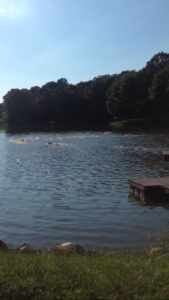
Practicing open water swimming in the lake. No flip turns required.
Flip turns have a mystique about them. Walk up to any pool and watch folks swimming laps. Your eyes will immediately go to the swimmers who do flip turns at the walls. It doesn’t matter if they are faster than the other swimmers, they will look fiercer because of the flip turn. Conversely, if, instead of doing flip turns, you saw Katie Ledecky or Michael Phelps sticking their heads up at the walls, gulping air, turning awkwardly half out of the water, then plunging back in for the next lap, they would seem significantly less fierce.
On swim teams in junior high and high school I did a lot of flip turns. Even with the flip turns, I never looked particularly fierce but they were a regular part of my swimming. When I started swimming again a few years ago, I gave myself permission not to include flip turns. It seemed like a good deal: expend my limited energy on the strokes and the laps themselves and give myself a little extra breath and time at the walls. I made this decision intentionally and unapologetically. The goal was more swimming, not “perfect” swimming. During these past few years, I have reserved the occasional flip turn for special circumstances, like the time I felt strong and energized hitting lap number 100 and joyously flipped at the wall to celebrate it.
Lately, I’ve been adding the flip turn back into my freestyle laps. I’m not entirely sure why. I’m considering an open water swim this summer but flip turns are completely unnecessary in lakes, so that’s not it. This most excellent and inspiring ode to the flip turn encouraged me but didn’t push me over the edge. I think it’s just time. Like it was time to get back in the pool a few years ago. Back then, I gave myself permission to swim without flip turns. Now, I’ve given myself permission to flip again (and sometimes, not to flip – as with the earlier deal with myself, I’m not after perfection and I’m not requiring all or nothing).
One of the things I hope this summer’s sabbatical will show me is how to distinguish between the need for rest and the need for persistence. How do I know when I’m hitting a groove I should explore and stick with, versus knowing when to back off, versus knowing when to go harder even though I’m already losing steam? Maybe I’m seeing part of the answer in swimming.
When you hit the wall you have several choices: 1) call it a day, stop swimming, and hang on for dear life, 2) grab as much air as you can every single second your head is out of the water while you turn around inelegantly but practically, then push off and carry on as best you can, or 3) make the turn as smooth and seamless a part of your stroke as possible, flipping around and using the wall itself to propel you in the next direction. They are all valid choices. I’m thankful for my unapologetic miles logged choosing #2. And really curious to see where #3 sends me.
*
Photo credit: Screen grab of video shot by P. Chambers, June 2016. Used with permission.
